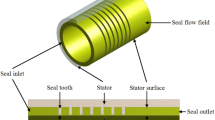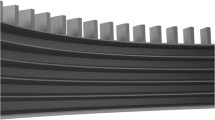Abstract
The governing equations are derived for the analysis of a stepped labyrinth gas seal generally used in high performance compressors, gas turbines, and steam turbines. The bulk-flow is assumed for a single cavity control volume set up in a stepped labyrinth cavity and the flow is assumed to be completely turbulent in the circumferential direction. The Moody’s wall-friction-factor model is used for the calculation of wall shear stresses in the single cavity control volume. For the reaction force developed by the stepped labyrinth gas seal, linearized zeroth-order and first-order perturbation equations are developed for small motion about a centered position. Integration of the resultant first-order pressure distribution along and around the seal defines the rotordynamic coefficients of the stepped labyrinth gas seal. The resulting leakage and rotordynamic characteristics of the stepped labyrinth gas seal are presented and compared with Scharrer’s theoretical analysis using Blasius’ wall-friction-factor model. The present analysis shows a good qualitative agreement of leakage characteristics with Scharrer’s analysis, but underpredicts by about 20 %. For the rotordynamic coefficients, the present analysis generally yields smaller predictied values compared with Scharrer’s analysis.
Similar content being viewed by others
Abbreviations
- A :
-
Circumferential cross-sectional area of control volume(m2)
- B :
-
Height of labyrinth tooth(m)
- C, c :
-
Direct and cross-coupled damping coefficients(N·s/m)
- C r :
-
Nominal clearance of seal(m)
- D :
-
Diameter of pipe(m)
- d :
-
Step height(m)
- e :
-
Absolute surface roughness(m)
- f :
-
Frequency ratio(Ω/ω)
- f B ,f M :
-
Fanning friction factors defined by Blasius’ and Moody’s model
- Fx, Fy :
-
Components of seal reaction force in x−y coordinate system(N)
- H :
-
Local seal clearance(m)
- K, k :
-
Direct and cross-coupled stiffness coefficients(N/m)
- L :
-
Pitch of labyrinth tooth(m)
- \(\dot m\) :
-
Mass flowrate per circumferential length (kg/(s·m))
- m, n :
-
Coefficients for Blasius’s friction model
- P :
-
Pressure(bar)
- R :
-
Gas constant(N·m/kg·K)
- R s :
-
Inlet radius of seal rotor(m)
- t :
-
Time(s)
- T :
-
Temperature(K)
- t p :
-
Labyrinth tooth width(m)
- V :
-
Average circumferential velocity in a labyrinth cavity(m/s)
- Z c :
-
Compressibility factor
- x,\(\dot x\):
-
Displacement and velocity of x-direction in rectangular coordinate(m, m/s)
- y,\(\dot y\):
-
Displacement and velocity of y-direction in rectangular coordinate(m, m/s)
- ɛ:
-
Eccentricity ratio
- θ:
-
Angular coordinate
- ϱ:
-
Fluid density (kg/m3)
- τ:
-
Shear stress(N/m2)
- ν:
-
Kinematic viscosity(m2/s)
- ω:
-
Rotor angular velocity (rad/s)
- 0, 1:
-
Zeroth and first-order perturbations
- s, r :
-
Stator, rotor
- i :
-
i-th cavity
References
Alford, J. S., 1965, “Protecting Turbomachinery from Self-Excited Rotor Whirl,”ASME Trans. Journal of Engineering for Power, pp. 333–344.
Childs, D. W., and Scharrer, J. K., 1986, “An Iwatsubo Based Solution for Labyrinth Seals: A Comparison to Experimental Results,”ASME Trans. Journal of Engineering for Gas Turbines and Power, Vol. 108, pp. 325–331.
Gurevich, M. I., 1966,The Theory of Jets In an Ideal Fluid, Pergamon Press, London, England, pp. 319–323.
Ha. T. W., and Childs, D. W., 1996, “A Rotordynamic Analysis of an Annular Honeycomb Seal Using a Two-Control Volume Model,”KSME International Journal, Vol. 10, No. 3, pp. 332–340.
Ha. T. W., and Lee, A. S., 1998, “Rotordynamic Analysis of Compressor Labyrinth Seals,”Journal of KSNVE, Vol. 8, No. 5, pp. 849–855.
Iwatsubo, T., 1980, “Evaluation of Instability Forces of Labyrinth Seals in Turbines or Compressors,” NASA CP 2133 Proceedings of a workshop at Texas A&M University 12–14 May Entitled Rotordynamic Instability Problems in High Performance Turbomachinery, pp. 139–167.
John, J. E. A., 1979, Gas Dynamics, Wylie.
Jenny, R. J., Wyssmann, H. P., and Pham, T. C., 1984, “Prediction of Stiffness and Damping Coefficients for Centrifugal Compressor labyrinth Seals,” ASME 84-GT-86. Presented at the 29th International Gas Turbine Conference and Exhibit, Amsterdam, The Netherlands.
Neumann, K. 1964, “Zur Frage der Verwendung von Durchblickdichtungen im Dampgturbinebau,” Maschinentechnik, 13(4).
Scharrer, J. 1987, “A Comparison of Experimental and Theoretical Results for Labyrinth Gas Seals,” Ph. D. Dissertation, Texas A& M University.
Scharrer, J. K., 1988, “Rotordynamic Coefficients for Stepped Labyrinth Gas Seals,”ASME/ASLE Tribology Conference, Paper No. 88-Trib-42.
Vermes, G., 1961, “A Fluid Mechanics Approach to the Labyrinth Seal Leakage Problem,”ASME Journal of Engineering for Power, Vol. 83, No. 2, pp. 161–169.
Author information
Authors and Affiliations
Corresponding author
Rights and permissions
About this article
Cite this article
Ha, T.W. Rotordynamic analysis for stepped-labyrinth gas seals using Moody’s friction-factor model. KSME International Journal 15, 1217–1225 (2001). https://doi.org/10.1007/BF03185662
Received:
Issue Date:
DOI: https://doi.org/10.1007/BF03185662




